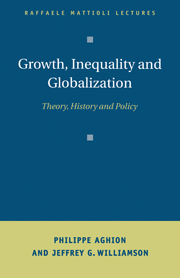Introduction
Published online by Cambridge University Press: 04 November 2009
Summary
One of us is a theorist, and one of us is an historian, but both of us are economists interested in modern debates about technical change, convergence, globalization, and inequality. The central bridge that spans theory and history over these debates is the Kuznets Curve.
In his Presidential address to the American Economic Association more than forty years ago, Simon Kuznets (1955) posed an hypothesis that still commands central attention in the pages of our journals. Kuznets suggested that in the long run, modern economic growth would generate an early industrialization phase of rising inequality, followed eventually by a mature industrialization phase of declining inequality. His idea was that income and wealth inequality within any country should tend to trace out an inverted U, a prediction subsequently called the Kuznets Curve.
Four decades ago, Kuznets had very little evidence to perform anything but a crude test of his hypothesis, and thus he was cautious. Yet, he was able to document falling inequality in many OECD countries in this century, some with the fall starting around World War I, some postponing the fall until 1929, but all sharing a revolutionary leveling of income and wealth from the 1920s to the 1960s. True, his evidence documenting a nineteenth century upswing of the Kuznets Curve was fragmentary at best, and he was not able to offer any evidence for either side of the Kuznets Curve for countries in East Europe, the Middle East, Latin America, Asia or Africa. In any case, debate about the facts has been intense ever since, perhaps because capitalism seems to be on trial.
- Type
- Chapter
- Information
- Growth, Inequality, and GlobalizationTheory, History, and Policy, pp. 1 - 4Publisher: Cambridge University PressPrint publication year: 1999

